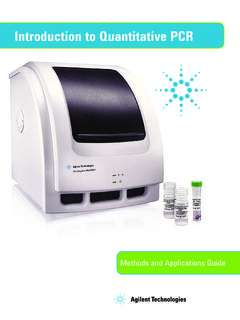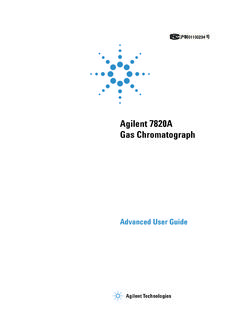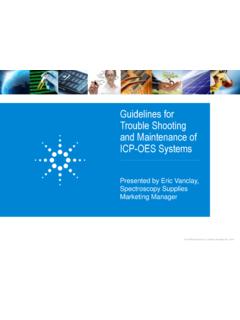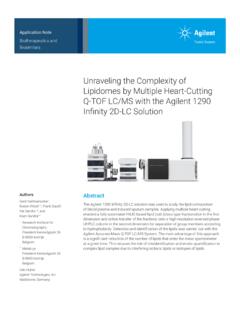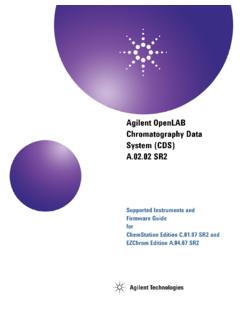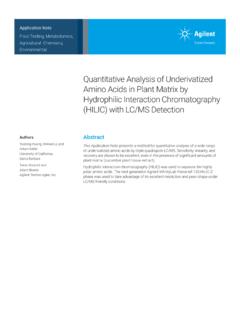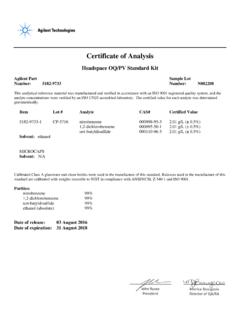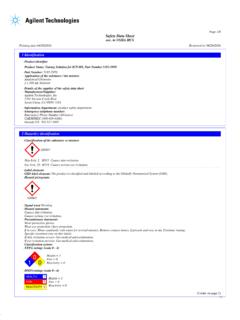Transcription of Applications of ICP-MS - Agilent
1 Applications of ICP-MSMeasuring Inorganic Impurities in Semiconductor ManufacturingApplication Compendium2 ICP-MS and ICP-QQQ in the Semiconductor Industry 4 Agilent s Three Decades of ICP-MS Experience Drives 7 Continuous InnovationAgilent ICP-MS Solutions for the Semiconductor Industry 8 Automating Analysis of Metal Contaminants in Si Wafers 9 Setups for Different Sample Types 11 Expanding Capabilities with Accessories and Software 15 Online Monitoring of Metal Contaminants in Process Chemicals 16 Contamination Control 17 ICP-MS Applications 18 Cleaning/Etching 19 Determination of ultra Trace Elements in High Purity Hydrogen Peroxide with 20 Agilent 8900 ICP-QQQD irect Analysis of Trace Metal Impurities in High Purity Nitric Acid Using ICP-QQQ 27 Analysis of Trace Metal Impurities in High Purity Hydrochloric Acid using ICP-QQQ 32 Analysis of Silicon, Phosphorus and sulfur in 20% Methanol using the Agilent 39 8800 Triple Quadrupole ICP-MSDetermination of ultra Trace Elements in Ultrapure Semiconductor Grade Sulfuric 45 Acid using the Agilent 8900 ICP-QQQ in MS/MS modeUltra-low Level Determination of Phosphorus, sulfur .
2 Silicon and Chlorine using 51 the Agilent 8900 ICP-QQQU ltra Trace Measurement of Potassium and Other Elements in Ultrapure Water 57 using the Agilent 8800 ICP-QQQ in Cool Plasma Reaction Cell ModeUltra Trace Measurement of Calcium in Ultrapure Water using the Agilent 8800 62 Triple Quadrupole ICP-MSAutomated Analysis of Semiconductor Grade Hydrogen Peroxide and DI Water 66 using ICP-QQQGas Chromatographic Separation of Metal Carbonyls in Carbon Monoxide with 74 Detection using Agilent 8800 ICP-QQQD irect Analysis of Trace Metallic Impurities in High Purity Hydrochloric Acid by 79 7700s/7900 ICP-MSDirect Measurement of Metallic Impurities in 20% Ammonium Hydroxide by 84 7700s/7900 ICP-MSDetermination of Trace Metal Impurities in Semiconductor Grade Phosphoric 89 Acid by High Sensitivity Reaction Cell ICP-MSPolymer Comparisons for the Storage and Trace Metal Analysis of Ultrapure 96 Water with the Agilent 7500cs ICP-MSContents> Search entire document3 Process Chemicals 101 Trace Level Analysis of Phosphorus, sulfur , Silicon and Chlorine in NMP using 102 the Agilent 8900 Triple Quadrupole ICP-MSSub-ppb Detection Limits for Hydride Gas Contaminants using GC-ICP-QQQ 109 Direct Analysis of Photoresist and Related Solvents Using the Agilent 7500cs 114 ICP-MSSilicon and Other Materials 120 Improvement of ICP-MS Detectability of Phosphorus and Titanium in High Purity 121 Silicon Samples using the Agilent 8800 Triple Quadrupole ICP-MSTrace Element Analysis of Trichlorosilane by Agilent 7700s/7900 ICP-MS 127 Characterization of Surface Metal Contamination on Silicon Wafers Using 132 Surface Metal Extraction Inductively Coupled Plasma Mass Spectrometry ( ICP-MS )Ultratrace Analysis of Solar (Photovoltaic)
3 Grade Bulk Silicon by ICP-MS 137 Analysis of Electroceramics by Laser Ablation ICP-MS 143> Search entire document4 ICP-MS and ICP-QQQ in the Semiconductor IndustryFigure 1. Simplified schematic showing typical steps in silicon wafer s technological world relies on the integrated circuits (ICs) that are found in devices ranging from manufacturing robots to smart light bulbs, and from mobile telephones to automobiles, aviation and aerospace. A silicon-based IC device is fabricated from millions of individual transistors (or switches) packed onto a silicon wafer chip. The device is built from patterned layers of oxide, polysilicon, silicon nitride dielectric, and conducting metal interconnects. Layers are connected by vias to form a 3D structure that provides the required computing or memory functionality. Silicon ingot is polishedSiO2 is depositedResist is spun onto wafer surfaceMask pattern is projected repeatedly onto waferMetal deposition/ dopingMulti-layer 3D structureResist is strippedSiO2 is etchedResist is developedExposed resistFinished waferChip diesPackaged processorWafer is sliced (diced) into individual dies can be several hundred on a 300 mm waferIn back-end operations the die is bonded, wired and packaged into the final circuitThe deposition, masking and etching process is repeated multiple times with insulating and conducting layersDuring the integrated circuit fabrication process (shown in Figure 1), each conducting or insulating layer is deposited, masked, and etched.
4 This leaves an intricate pattern of features with line widths as small as 10 nanometers (equivalent to about 40 Si atoms). Doped regions are added, depositing or implanting specific atoms to alter the conductivity of the silicon.> Return to table of contents> Search entire document5 The current 10 nanometer geometry contains features approximately 1000 times smaller than circuits manufactured in the 1970s. This reduced scale and increased density has required a parallel improvement in the control of contamination. The resultant need for higher-purity chemicals has led to ever-higher demands on the performance of the analytical instruments used to detect metallic impurities, a trend that is likely to metals in IC device fabricationSemiconductor device fabrication requires strict control of sources of contamination; industry estimates suggest that contamination accounts for around 50% of yield losses.
5 Metallic contaminants may be introduced via the wafer substrate or the chemicals used during the manufacturing and controlling trace element contamination begins with the high-purity wafer substrate. The substrate is usually silicon, but other materials such as silicon carbide, silicon nitride, and gallium arsenide are also used. High-purity electronic-grade silicon must be between 9N and 11N to purity. In terms of contamination, 9N purity means a maximum of one part per billion (ppb) of total impurity elements in the solid metallic contamination in bulk silicon can be measured by Inductively Coupled Plasma Mass Spectrometry ( ICP-MS ) after dissolving the Si in hydrofluoric acid. Trace metals in the sliced wafer are measured using a surface analysis technique such as vapor phase decomposition, where the metals are extracted from the Si substrate into a droplet that is then analyzed by addition to the high purity wafer substrate, the purity of chemicals used throughout the wafer fabrication process must be controlled to avoid introducing contaminants.
6 Metallic contaminants are of concern because they can affect the electrical properties of the finished device, for example by reducing dielectric breakdown voltage. As well as contaminants dissolved in process chemicals, insoluble nanoparticles are also monitored throughout the manufacturing in semiconductor manufacturingWhen ICP-MS was introduced in the 1980s, it was of great interest to semiconductor manufacturers and chemical suppliers due to its high sensitivity, low detection limits, and multi-element capability. Use of ICP-MS for semiconductor Applications increased rapidly in the 1990s, with the development of cool plasma on the HP 4500 instrument. Cool plasma allowed Na, K, Ca, and Fe to be determined at trace levels by ICP-MS , so semiconductor manufacturers and chemical suppliers no longer needed graphite furnace AAS to measure these specifications SEMI is a global semiconductor industry association that publishes standards and specifications for process chemicals and gases, among many other things.
7 Many semiconductor industry manufacturers are currently working with Grade 3 or 4 chemicals (Tier-B or Tier-C specifications, suitable for geometries between 800 and 90 nm). However, with the development of smaller architectures, there is pressure to move to Tier-D and Tier-E chemical specifications. Tier-E requires DLs below ppt and accurate spike recovery of target elements at ppt. Accurate analysis at these lower levels requires the higher performance of ICP-QQQ.> Return to table of contents> Search entire document6 ICP-MS manufacturers have continued to improve the technique, a major development being the release of the Agilent 8800 triple quadrupole ICP-MS (ICP-QQQ), in 2012. The 8800 and its successor, the Agilent 8900 ICP-QQQ, provide higher sensitivity, lower backgrounds, and better control of interferences than single quadrupole ICP-MS . This allows a greater number of contaminant elements to be monitored at lower concentrations, including previously difficult elements such as Si, P, S, and Cl.
8 Silicon and other materials Metal contamination in the silicon wafer substrate and associated layers and coatings can be monitored using surface metal extraction (SME) , also known as vapor phase decomposition (VPD). In the SME/VPD technique, the surface layer of the wafer (bare Si, or naturally or thermally oxidized SiO2) is dissolved using HF vapor. The dissolved metals are collected by scanning a droplet of a recovery solution (usually HF and H2O2, but sometimes an alternative solution such as HCl/H2O2) across the wafer surface. The droplet is then pipetted from the wafer surface and transferred to the ICP-MS for analysis. Other materials used in chip manufacturing are suitable for analysis using ICP-MS , including metal organic compounds such as trimethyl gallium (TMG), trimethyl aluminum (TMA), dimethyl zinc (DMZ), tetraethoxysilane (TEOS) and trichlorosilane (TCS).
9 Such compounds are precursors used to grow thin metal films or epitaxial crystal layers in metalorganic chemical vapor deposition (MOCVD) and atomic layer deposition. Pure metals such as Al, Cu, Ti, Co, Ni, Ta, W, and Hf are used as sputtering targets for physical vapor deposition (PVD) to create thin metal films on the wafer surface. High-k dielectric materials include chlorides and alcoxides of Zr, Hf, Sr, Ta, and the rare earth elements (REEs). Each of these materials has a limit for acceptable levels of contaminants, requiring analysis using and process chemicalsDuring IC fabrication, wafers undergo many processing steps, as illustrated in Figure 1. Chemicals used are in contact with the wafer surface, so control of contamination is critical. Examples of some commonly used chemicals are shown in Table 1. Among the most critical process chemicals in terms of controlling contamination are ultrapure water (UPW) and the RCA Standard Clean (SC) solutions SC-1 and SC-2.
10 The RCA cleaning procedure removes chemical contaminants and particulate impurities from the wafer surface without damaging the chip. SC-1 (NH4OH and H2O2 in deionized water (DIW)) removes organic residues, films and particles from the wafer surface. SC-2 (HCl and H2O2 in DIW) then removes ionic 1. Semiconductor process used chemicalsCleaningPure water, SC-1 (NH4OH and H2O2), SC-2 (HCl and H2O2), SPM (sulfuric peroxide mix, a mixture of H2SO4 and H2O2), DHF (dilute HF), IPA (isopropyl alcohol), methanolDevelopingPhotoresist, PGME (propylene glycol monomethyl ether), ethyl lactate, NMP (N-methyl pyrrolidone), TMAH (tetramethyl ammonium hydroxide)EtchingHF, NH4F, H3PO4, KOH, DMSO (dimethyl sulfoxide), MEA (mono-ethanol amine)PolishingCMP (chemical mechanical planarization) slurries, oxalic acid, NH4OH> Return to table of contents> Search entire document7 Agilent s Three Decades of ICP-MS Experience Drives Continuous InnovationWorking closely with leading semiconductor manufacturers and chemical suppliers since the late 1980s, Agilent has developed ICP-MS systems and Applications that help to address the challenges of this fast-moving industry.
